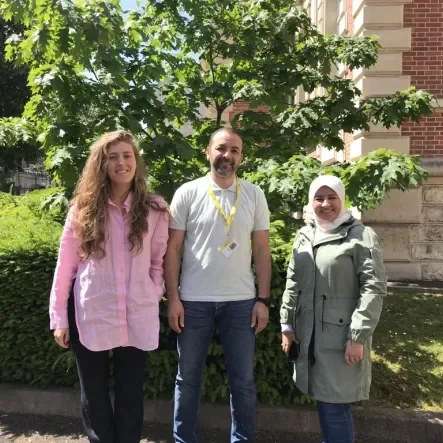Metagenomics Workshop: Insights from experts in human and animal virology and medical entomology

The Emergency Cell for Biological Intervention (CIBU) from Institut Pasteur and INIA team organized their second comprehensive five-day workshop on metagenomics, specifically designed for researchers in human & animal virology and medical entomology. The program, from May 22nd to 26th, 2023, focused on the practical aspects of sequencing pathogens' genetic materials.
Dive in this course with the insights of 3 experts, Ana Papkiauri, molecular biologist at National Center for Disease Control and Public Health of Georgia, Dr. Mervat Hamdy, researcher at Animal Health Research Institute (AHRI) of Egypt and Kamal Eddine Benallal, medical entomologist in a parasitic laboratory at Institut Pasteur d’Alger.
What motivated you to attend this workshop?
MERVAT: “Working in molecular biology and microbiology, I have come to appreciate the potential of metagenomics. I had some patients, cats and dogs, who exhibited respiratory symptoms, who tested negative for SARS-COV-2, something different was happening. Metagenomics, with its ability to comprehensively analyze genetic material, holds the promise of covering the full spectrum of viruses. Not only does it provide a tool to investigate the cases, using samples of tumor for example, it also opens up avenues for exploring a wide range of diseases and uncovering hidden connections.”
ANA: “In addition to our extensive experience in sequencing in our laboratory, we recognize the challenges and knowledge gaps associated with metagenomics. I thought this workshop would be a great resource for both myself and my institution. Also, while making diagnostic, we can face clinical samples where the specific pathogen or agent is unknown, in this situation, metagenomics proves to be very useful.”
KAMAL EDDINE: “I wanted to discover this new technology and its applicability in my field, particularly concerning vectors and lice. I have noticed a significant gap in the available data on sandflies compared to mosquitoes. Sandflies are overlooked due to their lack of transmission of highly dangerous viruses. However, they play an important role in transmitting harmful strains of parasites such as Leishmania sp.”
What do you think are the biggest advantages of using metagenomics in your field?
MERVAT: “When faced with clinical symptoms, we usually follow a process that involves sending the same sample to various departments; bacteriology, virology, molecular biology, and molecular genetics working independently, resulting in time-consuming and expensive tasks. Metagenomics serves as a universal technique that simultaneously analyzes multiple pathogens in a sample, saving time and costs. It also proves to be valuable in cases of co-infection, where multiple pathogens may be involved.”
KAMAL EDDINE: “As a medical entomologist, one major challenge is the distance between the field and the laboratory. I’m sometimes 2 000km away from my laboratory, transporting insects from the field is impractical. Metagenomics offers a remarkable advantage: it allows us to bring the laboratory to the field. This portability enables me to conduct analyses and generate insights on-site, eliminating the need for time-consuming and costly transportation.”
How will you apply your learnings back to your institution?
MERVAT: “Before attending this workshop, I had concerns about handling large amounts of data, I realized that analyzing extensive datasets is manageable with the appropriate tools and methodologies. We are planning to actively promote these tools and methodologies as well as the importance of metagenomics in our training department through informative lectures and spreading the word among our members.”
ANA: “We can access the presentations and videos of the workshop, allowing us to prepare informative lectures in our institution. I am eager to share the knowledge gained with my colleagues to implement metagenomics techniques effectively in our laboratory.”
KAMAL EDDINE: “The first step is to initiate a project implying metagenomics using our resources and staff. Once we have a solid grasp of this technology, we would organize an internal course, highlighting the advantages of metagenomics and encouraging others to join. Given the diverse expertise present in our institute, consolidating our knowledge in metagenomics can foster interdisciplinary collaboration.”

What did this training at the Institut Pasteur in Paris bring you?
ALL: “To summarize, we had the opportunity to enhance our knowledge of the latest metagenomic techniques, allowing us to discover specialized technologies and software tools to analyze complex microbial communities. Moreover, we accessed user-friendly websites and resources that we can share to our institutions. This workshop facilitated networking and cooperation among specialists from different disciplines fostering future collaborations. Finally, the true strength of this workshop lies in its ability to provide researchers with the opportunity to experiment and explore, promoting a dynamic learning process.”